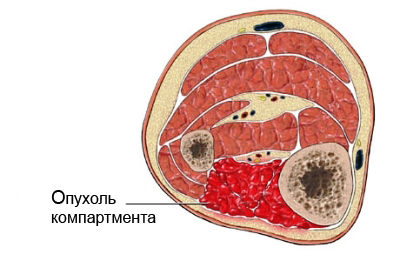Acute compartment syndrome – The CEC – Compartment syndrome – sharp – Volkmann's Ischemia
Description of acute compartment syndrome
If you have acute compartment syndrome (The CEC), increasing the pressure in the closed spaces, that keep muscles, nerves, and blood vessels. Because of this muscle do not get enough oxygen. USC may have an impact on the state of the hands, Brushes, Foot, Foot, and buttocks.

Causes of acute compartment syndrome
Under the skin of a person is connecting shell, called fascia. It covers the muscle groups, nerves and blood vessels. Fascia forms housings for these fibers, so called compartments. With strong pressure increases in these jewel cases, disturbed blood flow. Injury accelerates this process. Blood vessels die, which correspondingly leads to tissue necrosis.
Causes of acute compartment syndrome may include:
- Trauma (eg, by accident, Sports facilities, gunshot wound);
- Fracture (associated with the majority of cases);
- Vein obstruction;
- Burns;
- Bleeding;
- Edema (swelling of the tissues beneath the skin);
- Complication of surgery.
Risk factors for acute compartment syndrome
The following factors increase the risk of acute compartment syndrome:
- Procedure or illness, which can lead to fatal bleeding in cases of trauma:
- Admission anticoagulants;
- Coagulation failure (hemophilia);
- Participation in certain sports (eg, football)
- Bandages or perevяzki, wearing too tight or long, do not remove;
- The recent damage.
Symptoms of acute compartment syndrome
Similar symptoms can be caused not only by compartment syndrome, and other diseases. You must inform your doctor, If the following symptoms:
- Agony (even from minor injuries);
- The sense of density or swelling of muscles;
- Puffy, shiny skin on the affected area.
Symptoms may develop in the interval from 30 minutes to 2 hours. In other cases before the appearance of symptoms can take several days. Compartment syndrome – severe injury. Damage can result in serious complications or even death.
Diagnostics
For the diagnosis of acute kompartmenta Syndrome should undergo the following tests:
- Assays for measuring the pressure in the compartments (eg,through a catheter, tonometer);
- Near infrared spectroscopy – test for measuring the amount of oxygen in the tissue;
- MRT – test, which uses magnetic waves, to make pictures of structures in the body;
- Computed tomography - the type of X-ray, which uses computer, to make pictures of internal organs;
- Testing reflexes;
- Test range of motion.
Laboratory tests, to determine the degree of damage:
- The basic metabolic panel – to assess the state of the main body functions;
- General metabolic panel – to assess organ function.
- Complete blood count (complete blood count) – for the analysis of cells and substances, contained in the blood.
Acute compartment syndrome
Surgery, called fasciotomy, It should be made as quickly as possible, to reduce the pressure in the compartment and to prevent irreversible damage. The doctor makes a long incision in the fascia, to remove tissue fibers and relieve pressure.
Prevention of acute compartment syndrome
Acute compartment syndrome is difficult to prevent, because of its appearance there are many reasons. But there are some steps, to be taken, to reduce the risk of injury:
- Wear proper equipment when playing sports
- Remember the last time the use of anticoagulants or funds from blood diseases;
- Exercise caution when using the shroud.
